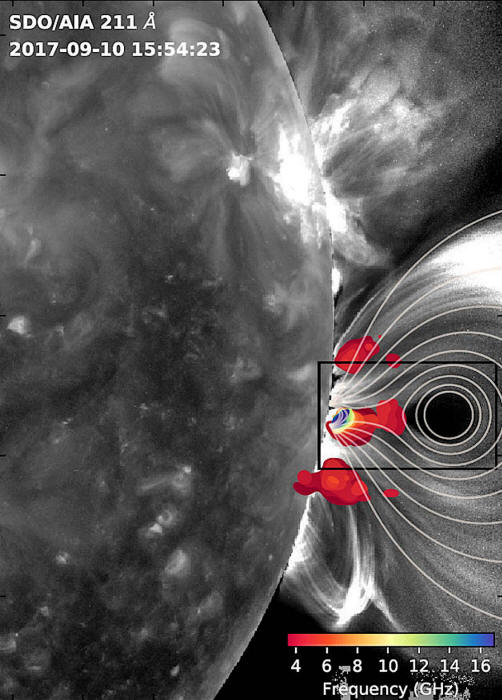|

by Stephen Smith
July 08,
2020
from
Thunderbolts Website

An ultraviolet image of a giant solar flare on 2017-09-10
as seen
by SDO, the Solar Dynamics Observatory.
These
high spatial resolution images confirm that
they
are the primary locations for
accelerating and channeling fast-moving electrons.
Credit:
NSF, NASA, and Chen et al. 2020.
As written several times in the past, in
an Electric Universe, the Sun lives
within a positive space charge sheath with respect to the
interstellar medium (ISM):
it isolates itself in
a cocoon of plasma.
The Sun is an anode
connected to galactic power circuits.
Those circuits are of
unknown potential, but they probably include energy sources
encompassing thousands of cubic light-years. The electrodynamic
forces moving through galactic "transmission lines" (Birkeland
currents) is also unknown, but astronomers constantly
report their amazement at solar flare output.
The Sun's heliospheric boundary is a double layer "cocoon", as
mentioned, isolating it from galactic plasmas flowing through the
ISM.
Voltage differences occur
within the
heliosphere, so the Sun, because it
is an electrical terminal, experiences charge/discharge phenomena
related to variable electrical input.
Sunspots and flares most likely
develop from changes in solar electrical supply.
An electrically active
Sun means that electric discharges penetrate the solar photosphere,
allowing electric charge to flow into its depths.
Electromagnetic flux
tubes expose the Sun's darker, cooler interior.
Those flux tubes
connect the Sun's electromagnetic field directly to Earth's
ionosphere.
How does that connection
manifest in Earth's environment?
This connection between the Sun and Earth was discussed in a
previous Picture of the Day, but it bears repeating.
Solar flares can
increase Earth's auroral displays because they are composed of
charged particles.
They follow Earth's
polar cusps, since they are electrical in nature.
On September 7,
2005 an X17 solar flare impacted
Earth's magnetosphere, knocking out radio transmissions and
overloading power station transformers.
Is it a coincidence that
hurricanes
Katrina (August 29, 2005) and
Rita (September 23, 2005) occurred
on either side of the fourth largest X-flare ever recorded?
Further evidence for solar electrical influence is that, 12 years
later,
hurricanes
Harvey (August 25, 2017) and
Irma (with wind speeds of 290
kilometers per hour on September 10, 2017) were spawned before
and after an
X9.3 flare on September 8 (the
eighth largest solar flare ever recorded) and then an X8.2 flare
on the same day.
At similar periods in the
solar cycle, within days of each other, violent electromagnetic
changes in the Sun initiated violent weather events on Earth.
The
Sun is an electric star.
When electricity
builds up beyond a trigger point within the Sun's inductive
fields, solar plasma discharges at near relativistic velocities
- solar flares could be like tremendous lightning bursts on the
Sun.
Electric Universe
advocate,
Wal Thornhill wrote:
"It is obvious from
looking at powerful mass expulsion activity in active stars and
galaxies that gravitational models are inadequate to explain
what is going on.
Gravity is an
attractive force only.
Recourse to magnetic
field behavior magically divorced from electric currents serves
merely to reinforce the mystical quality of modern physics
without telling us anything about the true cause."
| 

